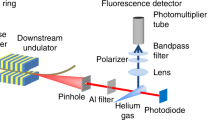Abstract
Synchrotrons produce continuous trains of closely spaced X-ray pulses. Application of such sources to the study of atomic-scale motion requires efficient modulation of these beams on timescales ranging from nanoseconds to femtoseconds. However, ultrafast X-ray modulators are not generally available. Here we report efficient subnanosecond coherent switching of synchrotron beams by using acoustic pulses in a crystal to modulate the anomalous low-loss transmission of X-ray pulses. The acoustic excitation transfers energy between two X-ray beams in a time shorter than the synchrotron pulse width of about 100 ps. Gigahertz modulation of the diffracted X-rays is also observed. We report different geometric arrangements, such as a switch based on the collision of two counter-propagating acoustic pulses: this doubles the X-ray modulation frequency, and also provides a means of observing a localized transient strain inside an opaque material. We expect that these techniques could be scaled to produce subpicosecond pulses, through laser-generated coherent optical phonon modulation of X-ray diffraction in crystals. Such ultrafast capabilities have been demonstrated thus far only in laser-generated X-ray sources, or through the use of X-ray streak cameras1,2,3,4,5,6.
This is a preview of subscription content, access via your institution
Access options
Subscribe to this journal
Receive 51 print issues and online access
$199.00 per year
only $3.90 per issue
Buy this article
- Purchase on Springer Link
- Instant access to full article PDF
Prices may be subject to local taxes which are calculated during checkout



Similar content being viewed by others
References
Kieffer, J.-C. et al. Ultrafast X-ray sources. Phys. Fluids B 5, 2676–2681 (1993).
Rousse, A. et al. Efficient Kα x-ray source from femtosecond laser-produced plasmas. Phys. Rev. E 50, 2200–2207 (1994).
Murnane, M. M. et al. Ultrafast X-ray pulses from laser-produced plasmas. Science 251, 531–536 (1991).
Schoenlein, R. W. et al. Femtosecond X-ray pulses at 0.4Å generated by Thomson scattering: A tool for probing the structural dynamics of materials. Science 274, 236–238 (1996).
Schoenlein, R. W. et al. Generation of femtosecond pulses of synchrotron radiation. Science 287, 2237–2240 (2000).
Larsson, J. et al. Ultrafast x-ray diffraction using a streak-camera detector in averaging mode. Opt. Lett. 22, 1012–1014 (1997).
Batterman, B. & Cole, H. Dynamical diffraction of X rays by perfect crystals. Rev. Mod. Phys. 36, 681–716 (1964).
Warren, B. E. X-Ray Diffraction (Dover, New York, 1990).
Zachariasen, W. H. Theory of X-ray Diffraction in Crystals (Wiley and Sons, New York, 1945).
Borrmann, G. & Hildebrandt, G. Rontgen-Wellenfelder in Grossen Kalkspatkristallen und die Wirkung Einer Deformation. Z. Naturforsch. A 11, 585–587 (1956).
Hauer, A. & Burns, S. J. Observation of an x-ray shuttering mechanism utilizing acoustic interruption of the Borrmann effect. Appl. Phys. Lett. 27, 524–526 (1975).
Entin, I. R. et al. X-ray acoustic resonance in a perfect silicon crystal. Sov. Phys. Solid State 20, 754–756 (1978).
LeRoux, S. D., Colella, R. & Bray, R. X-ray diffraction studies of acoustoelectrically amplified phonon beams. Phys. Rev. Lett. 35, 230–234 (1975).
Chapman, L. D., Colella, R. & Bray, R. X-ray diffraction studies of acoustoelectrically amplified phonons. Phys. Rev. B 27, 2264–2277 (1983).
Authier, A., Lagomarsino, S. & Tanner, B. K. (eds) X-ray and Neutron Dynamical Diffraction, Theory and Applications (Plenum, New York, 1996).
Thomsen, C. et al. Surface generation and detection of phonons by picosecond light pulses. Phys. Rev. B 34, 4129–4138 (1986).
Akhmanov, S. A. & Gusev, V. E. Laser excitation of ultrashort acoustic pulses: new possibilities in solid-state spectroscopy, diagnostics of fast processes, and nonlinear acoustics. Sov. Phys. Usp. 35, 153–191 (1992).
Rose-Petruck, C. et al. Picosecond-milliangstrom lattice dynamics measured by ultrafast X-ray diffraction. Nature 398, 310–312 (1999).
Lindenberg, A. et al. Time-resolved X-ray diffraction from coherent phonons during a laser induced phase transition. Phys. Rev. Lett. 84, 111–114 (2000).
Reis, D. A. et al. Probing impulsive strain with X-ray pulses. Phys. Rev. Lett. 86, 3072–3075 (2001).
Auston, D. H. & Shank, C. V. Picosecond ellipsometry of transient electron-hole plasmas in germanium. Phys. Rev. Lett. 32, 1120–1123 (1974).
Young, J. F. & van Driel, H. M. Ambipolar diffusion of high-density electrons and holes in Ge, Si, and GaAs: many-body effects. Phys. Rev. B 26, 2147–2158 (1982).
Acknowledgements
We thank R. Colella and J. Wark for discussions, and D. Arms for technical support. This work was conducted at the MHATT-CAT insertion device beamline at the Advanced Photon Source. Use of the Advanced Photon Source was supported by the US Department of Energy Basic Energy Sciences, Office of Energy Research. We also acknowledge partial support from the National Science Foundation, the Center for Ultrafast Optical Science, and the AFOSR through the MURI programme.
Author information
Authors and Affiliations
Corresponding author
Rights and permissions
About this article
Cite this article
DeCamp, M., Reis, D., Bucksbaum, P. et al. Coherent control of pulsed X-ray beams. Nature 413, 825–828 (2001). https://doi.org/10.1038/35101560
Received:
Accepted:
Issue Date:
DOI: https://doi.org/10.1038/35101560
This article is cited by
-
Demonstration of quantum synchronization based on second-order quantum coherence of entangled photons
Scientific Reports (2016)
-
Controlling X-rays with light
Nature Physics (2010)
-
Optical switching of fs laser produced Kα-radiation using the Borrmann effect
Applied Physics B (2005)
-
Slick switching of X-rays
Nature (2001)
Comments
By submitting a comment you agree to abide by our Terms and Community Guidelines. If you find something abusive or that does not comply with our terms or guidelines please flag it as inappropriate.



